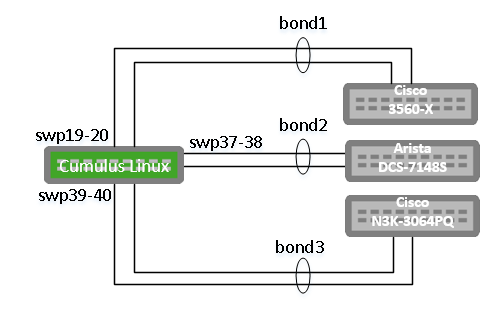Bond Interoperability with Cisco and Arista Switches
This knowledge base article discusses interoperability and troubleshooting in a mixed switch topology, featuring switches running Cumulus Linux on the same network as switches running Cisco and Arista network OSes. The article uses the syntax of ifupdown2.
Environment
- Cumulus Linux 2.1 and later
Example Mixed Switch Topology
The three examples described below use the following diagram, with all testing performed on actual equipment. Both sides use the same interfaces; for example, swp19 (switch port 19) on the Cumulus Linux switch connects to g0/19 (Gigabit Ethernet 0/19) on the Cisco 3560.

Cumulus Linux and Cisco IOS
The following example utilizes slow LACPDUs (that is, bond-lacp-rate is set to 0):
| Quanta LY2 w/Cumulus Linux 4.2.0 | Cisco WS-C3560X-24 12.2(55)SE5 |
|---|---|
auto bond1 |
vlan 10 |
Cumulus Linux and Arista EOS
The following example utilizes fast LACPDUs (where bond-lacp-rate is set to 1):
| Quanta LY2 w/Cumulus Linux 4.2.0 | Arista DCS-7148S-R 4.13.5F |
|---|---|
auto bond2 |
interface Ethernet37 |
Cumulus Linux and Cisco NX-OS
The following example utilizes fast LACPDUs (where bond-lacp-rate is set to 1):
| Quanta LY2 w/Cumulus Linux 4.2.0 | Cisco Nexus3064 5.0(3)U2(2c) |
|---|---|
auto bond3 |
feature interface-vlan |
Troubleshooting Bond/EtherChannel/LACP Links
The three most common problems with EtherChannels are:
- VLAN mismatches with layer 2 bonds
- Fast vs slow LACP rate of LACPDUs
- Both sides using passive LACP mode instead of active LACP mode
Because Cumulus Linux is Linux, it utilizes the same kernel syntax for bonds that you can find in the kernel.org documentation. The Cumulus Linux bonding documentation contains specific examples. The following guide compares the Cisco 3560 to the Quanta LY2 in the diagram and configuration above.
Bond Parameters
Here is the recommended way to configure a bond in Cumulus Linux:
auto bond0
iface bond0
bond-slaves swp1 swp2
bond-mode 802.3ad
bond-miimon 100
bond-lacp-rate 1
bond-min-links 1
bond-xmit-hash-policy layer3+4
bond-slavesequates to the members of the bond. In this case, swp1 and swp2 are members of bond0; LACP bonds requirebond-mode802.3ad.bond-miimon 100is the failure inspection frequency. The default value is 0, but NVIDIA recommends 100.bond-lacp-rate 1means fast LACP, see Fast vs Slow LACP Rates below; NVIDIA recommends using fast LACP.bond-min-linksis an integer indicating the number of links that must be up for the bond to become active.bond-xmit-hash-policymust be set to layer3+4 so it is evenly distributed.
To read more information about the bond parameters, read the kernel.org documentation.
VLAN Mismatch
The following configuration has a VLAN mismatch. Can you find it?
| Quanta LY2 w/Cumulus Linux 4.2.0 | Cisco WS-C3560X-24 12.2(55)SE5 |
|---|---|
auto bond1 |
vlan 10 |
As illustrated above, the bridge called vlan10 indicates the member of this bridge is bond1.100. The name vlan10 does not mean that you have to tag the bridge members with vlan10. The name has nothing to do with what 802.1q tags are within the bridge. The subinterface .100 (bond1.100) indicates that tagged ingress packets become a member of VLAN 100, but in a bridge named vlan10. This syntax is correct but might not be the result you want. You could name the bridge anything, such as mgmt-bridge, or outofband.
Unlike Cisco IOS, Cumulus Linux drops packets unless you join the tagged subinterface to a bridge or layer 3 interface. Many IOS and IOS-look-alikes do something like this:
switchport trunk allowed vlan 5
This allows only vlan5 and nothing else. Cumulus Linux does the opposite, where it drops everything unless it allows it in.
You can find more information on configuring VLAN tagging in the Cumulus Linux user guide.
Fast vs Slow LACP Rates
The Cumulus Linux documentation recommends:
bond-lacp-rate 1
This means fast; according to the kernel.org documentation, it means “Request partner to transmit LACPDUs every 1 second.”
In some cases, the other vendor cannot perform fast LACPDUs or there might be some other unknown requirement requiring slow LACP. To configure slow rate, use:
bond-lacp-rate 0
According to kernel.org, this means “Request partner to transmit LACPDUs every 30 seconds.”
Troubleshooting Fast vs Slow
To see a bond configuration and what it runs, use this command:
cat /proc/net/bonding/bond1
The following output is a snippet of the information received:
cumulus@switch:~$ cat /proc/net/bonding/bond1
Ethernet Channel Bonding Driver: v3.7.1 (April 27, 2011)
Bonding Mode: IEEE 802.3ad Dynamic link aggregation
Transmit Hash Policy: layer3+4 (1)
MII Status: up
MII Polling Interval (ms): 100
Up Delay (ms): 0
Down Delay (ms): 0
802.3ad info
LACP rate: slow
On the Cisco switch, you check the port channel like this:
show etherchannel summary
The following output is a snippet of the information received:
Group Port-channel Protocol Ports
------+-------------+-----------+-----------------------------------------------
1 Po1(SU) LACP Gi0/19(P) Gi0/20(P)
Notice that the port channel is up on both ports and looks good. To see the LACPDU’s speed on the Cisco side, run the following command:
show etherchannel detail
The following output is a snippet of the information received:
Local information:
LACP port Admin Oper Port Port
Port Flags State Priority Key Key Number State
Gi0/19 SA bndl 32768 0x1 0x1 0x114 0x3D
Partner's information:
LACP port Admin Oper Port Port
Port Flags Priority Dev ID Age key Key Number State
Gi0/19 SA 255 089e.01ce.e216 3s 0x0 0x11 0x1 0x3D
Where the SA flags mean:
A - Device is in active mode
S - Device is sending Slow LACPDUs
Making sure both sides match is imperative for traffic to pass and the bond to stay up and be stable. In the case above, they were both utilizing slow LACPDUs. The following table helps you match:
| Cumulus Linux | Cisco | Rate |
|---|---|---|
| LACP rate: slow | S | every 30 seconds |
| LACP rate: fast | F | every second |
Active vs Passive Modes
Cumulus Linux does not currently support passive mode. Because active mode works with active and passive configurations, and Cumulus Linux does not have a knob to change it, there is no interoperability issue between switches running Cumulus Linux and switches from other network OS vendors.